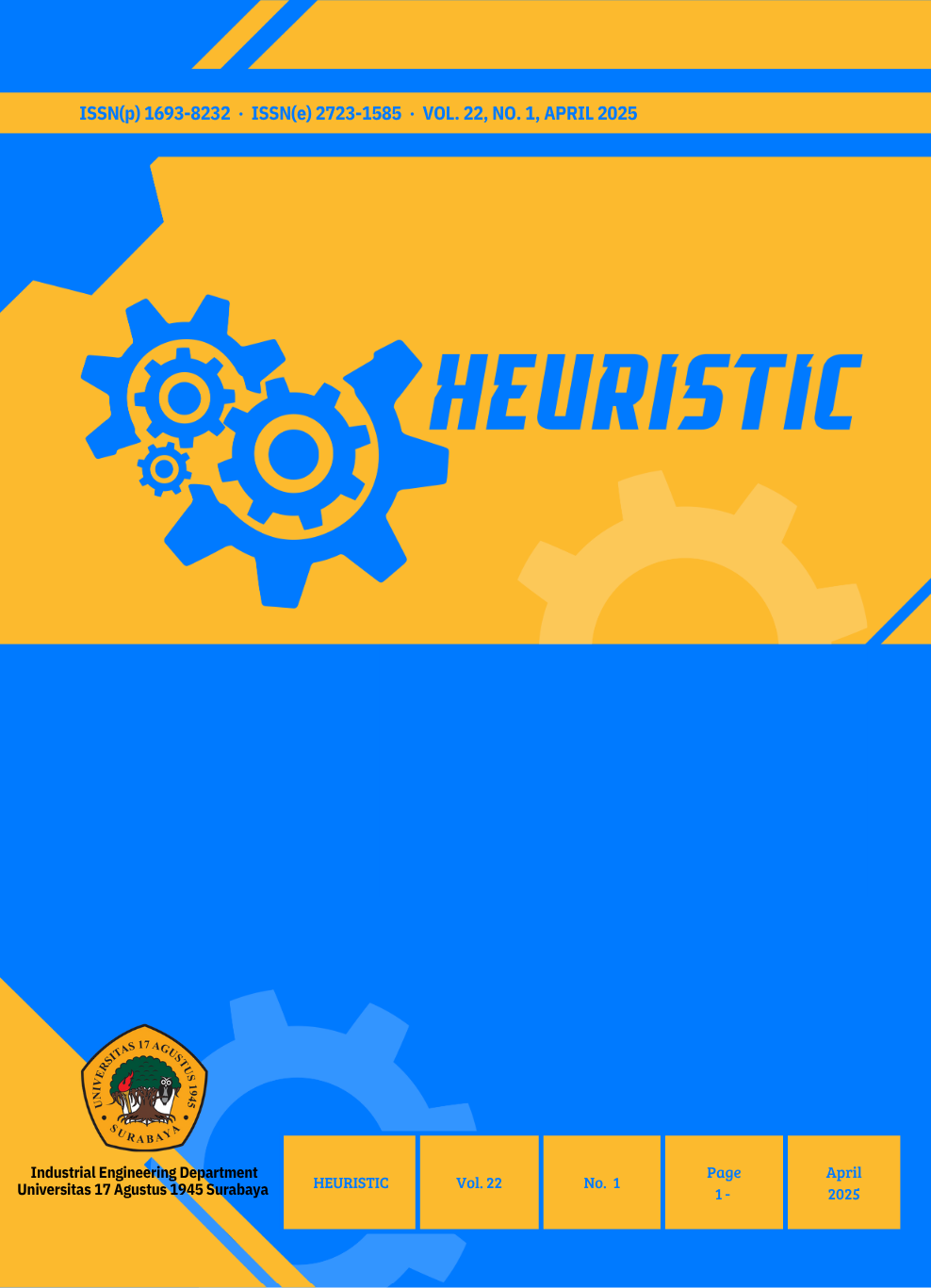Engineering Livestock Feed for Goat Fattening to Increase Farmer Profit and Sustainable Supply Chain
DOI:
https://doi.org/10.30996/heuristic.v22i1.132163Keywords:
Efficiency; Farmer Profitability; Feed Innovation; Goat Productivity; SustainabilityAbstract
The demand for goat meat continues to increase annually, both for daily consumption and religious events such as Aqiqah and Qurban. However, production has not kept up with demand due to the limitations of goat growth and fattening processes, mainly caused by dependence on green feed which relies on land availability and weather conditions. This supply-demand imbalance often results in the slaughter of young goats. Factors contributing to this gap include the continued reliance on forage and concentrate-based feeds, which are not only costly but also slow in promoting meat growth and reproductive cycles. Feed innovation is introduced to support sustainable goat farming systems. The innovation involves providing dry feed without forage, using a fermentation process of liquid nutrients mixed with ground corn cobs and added concentrate. Dry feed helps reduce operational costs by eliminating the need for forage collection. It also simplifies the fattening and care process, increases meat productivity, and ultimately enhances farmers’ social welfare through greater profits. The study applied dry feed to 30 goats using a dynamic simulation model to evaluate growth and income, contributing to food security. Dry feed increased monthly weight gain to 3 kg from the previous 2 kg using green feed and concentrate. It yielded a net profit of IDR 104,600 per goat/month, compared to IDR 55,000. When applied to 30 goats, farmer profits increased from IDR 1,650,000 to IDR 3,138,000/month. The results show that dry feed significantly increases farmer income, encouraging more goat farming activities and strengthening food security in the goat meat sector.Downloads
References
Maesya, A., & Rusdiana, S. (2018). Prospek Pengembangan Usaha Ternak Kambing dan Memacu Peningkatan Ekonomi Peternak. Agriekonomika, 7(2), 135. https://doi.org/10.21107/agriekonomika.v7i2.4459
Ramadhan, J. B., Rahmawan, G. H., Rahmah, T. N., & Wati, S. F. A. (2024). Model Sistem Dinamis Dalam Meningkatkan Efisiensi Rantai Pasok Telur Ayam Di Bojonegoro. Koloni, 3(2), 261–271. https://koloni.or.id/index.php/koloni/article/view/651%0Ahttps://koloni.or.id/index.php/koloni/article/download/651/600
Wahid, M. A., Usfah, A., & Rohman, A. (2024). Inovasi Pemanfaatan Limbah Janggel Jagung Sebagai Bahan Tambah Untuk Pakan Fermentasi Ternak Kambing. Madaniya, 5(1), 278–284. https://doi.org/10.53696/27214834.756
Siregar, H., & Ilyas, S. (2018). Manajemen Pakan dan Nutrisi dalam Usaha Ternak Ruminansia. Jakarta: Penebar Swadaya.
Daryanto, A. (2013). Agribisnis Ternak yang Berdaya Saing. Bogor: IPB Press.
Siregar, A. R., & Ilyas, S. (2018). Strategi Peningkatan Produktivitas Ternak Melalui Pemberian Pakan Alternatif Berbasis Limbah Lokal. Prosiding Seminar Nasional Teknologi Peternakan, 5(1), 54–59.
Devendra, C., & Liang, J. B. (2012). Meat production from goats in Asia: Prospects and challenges. Small Ruminant Research, 89(2–3), 107–111. https://doi.org/10.1016/j.smallrumres.2009.12.033
Wahid, A., Mulyono, D., & Zakaria, A. (2024). Efektivitas Pakan Fermentasi terhadap Pertumbuhan Kambing Potong. Jurnal Ilmu Ternak Nusantara, 16(2), 87–93.
Wibowo, R. A., Astuti, T., & Huda, N. (2021). Analisis Permintaan Daging Kambing di Masa Idul Adha. Jurnal Agribisnis dan Peternakan, 10(1), 12–19.
Babiker, S. A., El Khider, I. A., & Shafie, S. A. (1990). Chemical composition and quality attributes of goat meat and lamb. Meat Science, 28(4), 273–277. https://doi.org/10.1016/0309-1740(90)90047-4
Kurniawan, K., Puspa, D. G. P., Mukti, W. A., Zahra, N. K. A., Ramadhani, A. S., Handayani, E., Nurhida, D., Wirawan, N. R., & Darmawan, A., "Optimalisasi Pakan dengan Penggunaan Feed Supplement sebagai Upaya Pengembangan Peternakan di Desa Karangtengah, Banjarnegara," Jurnal Pengabdian Ilmiah Masyarakat, vol. 6, no. Khusus, pp. 24–32, 2024.
Nugroho, I. A., Rizqiana, S., & Syarifuddin, N. A., "Performa Kambing Peranakan Etawah (PE) Jantan yang Memperoleh Suplementasi Urea Moringa Molasses Multinutrien Block (UMMMB) dalam Ransum," Jurnal Penelitian Peternakan Lahan Basah, vol. 3, no. 1, pp. 20–26, 2023.
Junaidi, F., & Widiantoro, D., "Pengembangan Teknologi Fermentasi Pakan Berbasis Hijauan untuk Peningkatan Kualitas Nutrisi pada Ternak Kambing (Rojokoyo Farm)," Jurnal Sains dan Teknologi, vol. 1, no. 1, pp. 76–82, 2024
Khaeri, A., Laili, A., Agustinr, D., & Atma, C. D., "Penerapan Inovasi Fermentasi Limbah Daun Kering sebagai Pakan Ternak Kambing," Sinapmas, vol. 3, no. 1, pp. 1–6, 2023.
Khirzin, M. H., Sanjaya, A. W., & Laksanawati, T. A., "Peningkatan Produktivitas Peternak Kambing Melalui Pelatihan Pembuatan Stok Pakan dan Pengolahan Kotoran di Desa Labanasem, Banyuwangi," Jurnal Pengabdian Masyarakat Berkemajuan, vol. 7, no. 4, pp. 1–8, 2023.
Downloads
Published
How to Cite
Issue
Section
License
Authors who publish with Heuristic agree to the following terms:
- Authors transfer the copyright and grant the journal right of first publication with the work simultaneously licensed under a Creative Commons Attribution-ShareAlike 4.0 International License.. that allows others to share the work with an acknowledgement of the work's authorship and initial publication in this journal.
- Authors are able to enter into separate, additional contractual arrangements for the non-exclusive distribution of the journal's published version of the work (e.g., post it to an institutional repository or publish it in a book), with an acknowledgement of its initial publication in this journal.
- Authors are permitted and encouraged to post their work online (e.g., in institutional repositories or on their website) prior to and during the submission process, as it can lead to productive exchanges, as well as earlier and greater citation of published work (See The Effect of Open Access)










